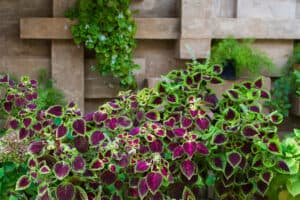Coleus (Plectranthus scutellarioides, also called Solenostemon scutellarioides, formerly Coleus blumei), commonly known as painted nettle or flame nettle, is a perennial plant belonging to the Lamiaceae family.
Its eye-catching, colorful, and bright leaves, together with its rapid growth and easy reproduction, make it a popular ornamental plant. They usually grow bushy, measuring between 1 and 3 feet tall. Its leaves grow opposite each other, and the stem is quadrangular. As for the color, they vary from black — dark purple — to light yellow, either a single color or variegated. Their shape can be ovate or lanceolate, and their edges can be serrated or smooth.
There are almost 300 coleus species and about 1,500 varieties, and botanists have changed their names on several occasions following phylogenetic research. In this article, we’ll cover what we believe are the 20 best coleus cultivars that will brighten your garden and home.
Coleus Cultivars
Although coleus has no confirmed origin, it is probably native to Southeast Asia. The plant arrived in Europe in the 19th century when naturalist Karl Ludwig Blume brought it from Java to beautify European gardens.
Coleus became fashionable throughout the 19th century, although its cultivation declined during the 20th century. Interestingly, gardeners have been growing it again for the past few decades. As a result, a wide variety of cultivars are available, but here are the 20 best types for your garden.
Wizard Jade
Height: 12 to 14 inches tall
Spread: 10 to 12 inches wide
Exposure: Partial sun or shade
Description: ‘Wizard Jade’ requires little maintenance and tends to grow upright rather than bushy. Its leaves are medium-sized and oval, with a pointed green edge and a very light yellow, almost white, interior. Both colors are balanced, forming a striking visual pattern, but this plant can also complement other colorful plants like impatiens. This variety is ideal for a houseplant.
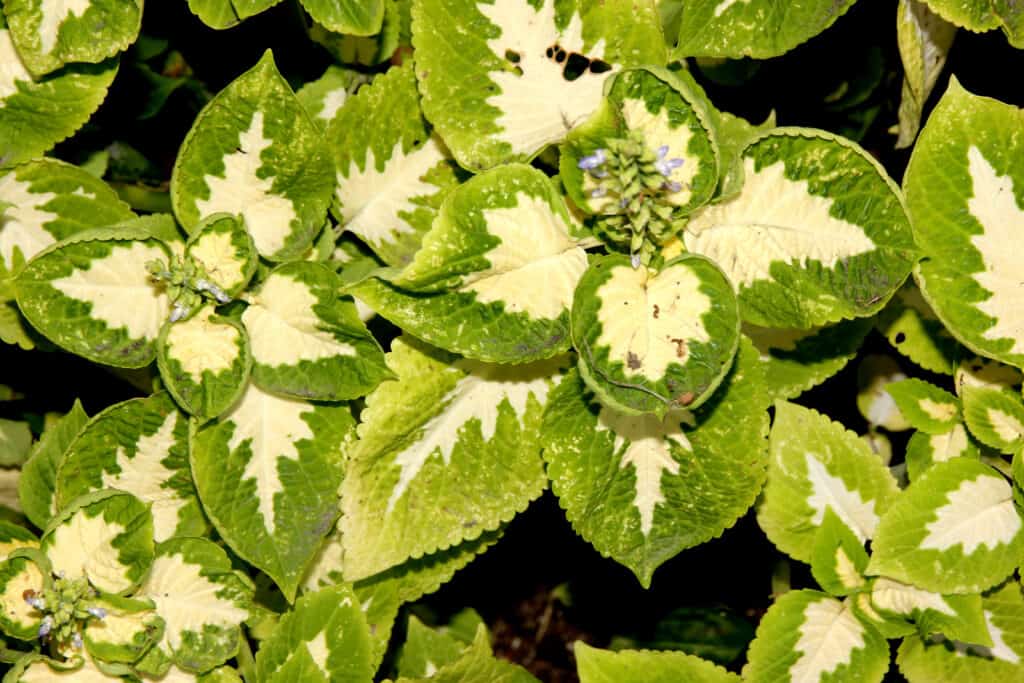
‘Wizard Jade’ tends to grow upright, reaching an average height of 12-14 inches tall.
©Gurcharan Singh/Shutterstock.com
Wizard Rose
Height: 12 to 14 inches tall
Spread: 10 to 12 inches wide
Exposure: Partial sun or shade
Description: ‘Wizard Rose’ is a prevalent variety in gardens worldwide. This cultivar is moderate-sized, grows upright, and is a late bloomer. Its leaves are medium-sized, with a bright pink heart, surrounded by a thin white border and a thicker, green outer edge.

‘Wizard Rose’ coleus has vibrant pink patches on its leaves.
©Astfreelancer/Shutterstock.com
Wizard Velvet Red
Height: 12 to 14 inches tall
Spread: 10 to 12 inches wide
Exposure: Partial sun or shade
Description: ‘Wizard Velvet Red’ is an ideal variety to add a colorful splash to your garden or home interior. Its leaves are bright red, medium-sized, with thin, pointed green edges. It grows vertically and is moderate-sized, requiring little care.
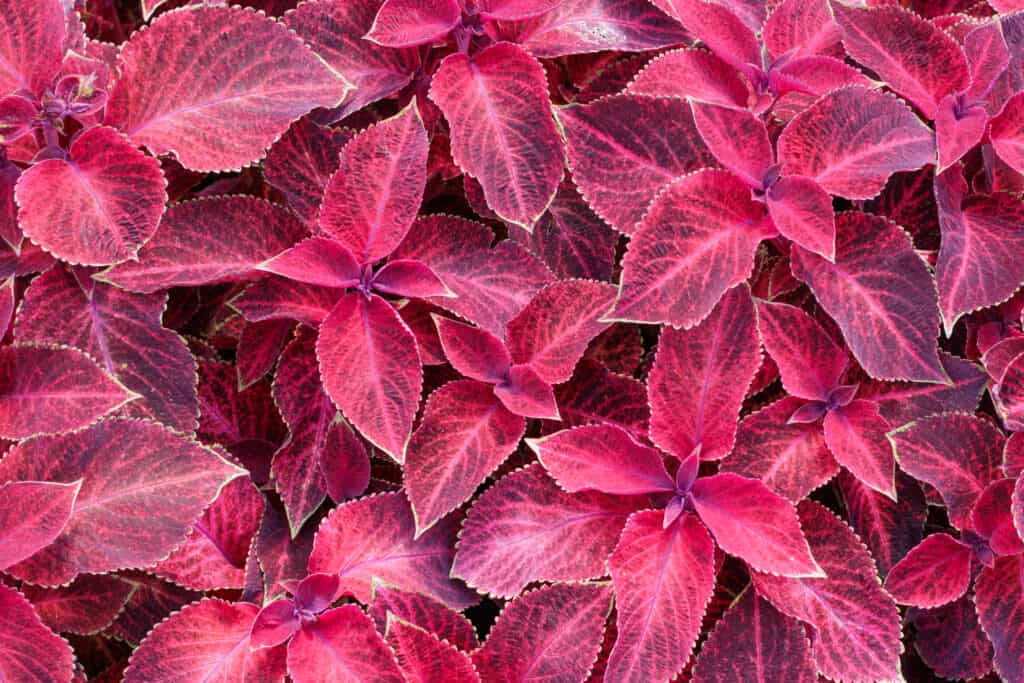
‘Wizard Velvet Red’ coleus features a thin edge of green around its leaves.
©Irina Kononova/Shutterstock.com
Giant Exhibition Magma
Height: 16 to 20 inches tall
Spread: 16 to 20 inches wide
Exposure: Shade or filtered sunlight
Description: ‘Giant Exhibition Magma’ is a more robust plant requiring a moist substrate. Its leaves are large, covered in a deep burgundy color, with a thin light green border. This is a very showy variety, making it an outstanding addition to your garden alongside lighter, more colorful plants, such as lantana.
Giant Exhibition Rustic Red
Height: 16 to 20 inches tall
Spread: 16 to 20 inches wide
Exposure: Partial sun or light shade
Description: This variety requires well-fertilized and moist soil, thriving in soil or a pot in a bright environment. Its leaves are large and rusty red with thin yellow edges.
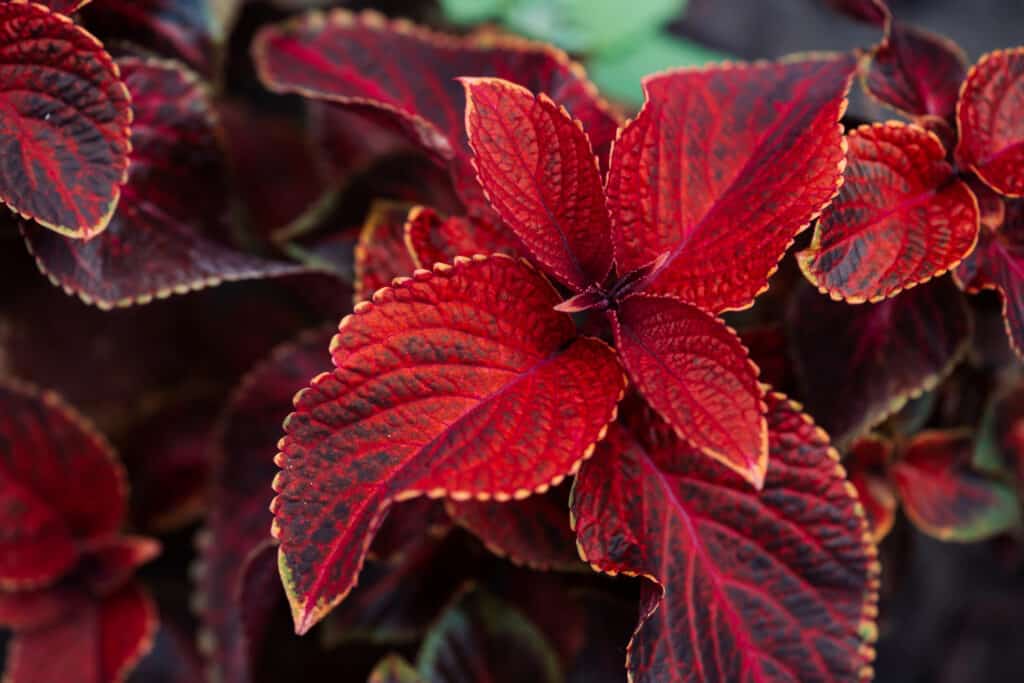
‘Giant Exhibition Rustic Red’ coleus is a rich, deep red color with yellow edges on its leaves.
©daniilphotos/Shutterstock.com
Giant Exhibition Limelight
Height: 12 to 16 inches tall
Spread: 12 to 15 inches wide
Exposure: Partial or full shade
Description: This is a small, vigorous plant, which adapts very well to a pot, but can live in the garden. It grows in a rounded shape, and its lime-green leaves have serrated edges. The color is uniform and bright, making ‘Limelight’ an excellent choice for brightening your garden or complementing darker, flowering plants, such as begonias.
Giant Exhibition Palisandra
Height: 16 to 20 inches tall
Spread: 16 to 20 inches wide
Exposure: Partial to full shade
Description: This is a very elegant cultivar due to its dark, large, velvety leaves. Its color is dark purple to black, so it can draw attention on its own or contrast with more colorful plants. It is suitable for outdoor or indoor cultivation and prefers moist soil with good drainage.
Black Dragon
Height: 12 to 14 inches tall
Spread: 10 to 12 inches wide
Exposure: Partial sun or shade
Description: Its serrated, velvety leaves and dark red color with deep purple edges give this cultivar a unique appearance. This variety is captivating and will make a great addition to your home. It can be grown in the ground or adapted to a pot as long as it has a well-drained, moist substrate.

‘Black Dragon’ coleus is a moody red with dark purple edges.
©Lana B/Shutterstock.com
Henna
Height: 14 to 28 inches tall
Spread: 14 to 16 inches wide
Exposure: Full sun or part shade
Description: What better example than ‘Henna’ when talking about exotic cultivars? This variety has pointed, serrated leaves with a pale green heart, pink edges, and a dark pink underside. This plant tolerates heat and requires little maintenance, although fertilizing it with humus does not hurt.

Henna coleus is a lovely ornamental plant that requires little maintenance.
©marekuliasz/Shutterstock.com
Chocolate Covered Cherry
Height: 12 to 14 inches tall
Spread: 10 to 12 inches wide
Exposure: Full sun in humid climates or partial shade when humidity is low
Description: This is a classic coleus variety that thrives in soil and pots, preferring a moist substrate. Its leaves are heart-shaped with serrated edges. Its center is magenta, surrounded by dark burgundy, and with a thin, light green outer edge. It is striking on its own, but you can plant it next to greener plants to make it stand out.
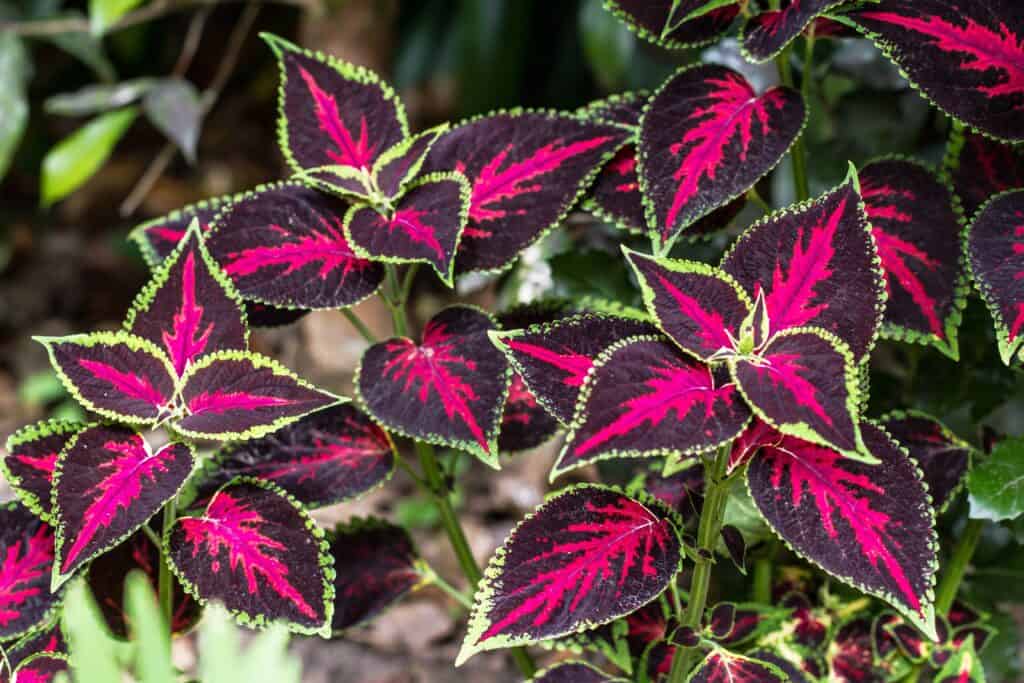
‘Chocolate Covered Cherry’ coleus features heart-shaped leaves of rich colors.
©Dafinka/Shutterstock.com
Kong Jr. Green Halo
Height: 18 to 24 inches tall
Spread: 20 to 35 inches wide
Exposure: Partial sun or shade
Description: This cultivar is heat resistant and requires little maintenance, both in soil and in pots. Its huge leaves are heart-shaped, with a cream-colored center and wide, bright green edges. It grows pretty fast but tidy, and it thrives indoors.
Mighty Mosaic
Height: 18 to 26 inches tall
Spread: 18 to 22 inches wide
Exposure: Partial sun or shade
Description: This plant is a candidate to take center stage in your garden, although you can plant it indoors in a pot without any problems. Its leaves have vibrant patterns combining green, yellow, and red shades. In addition, ‘Mighty Mosaic’ tolerates direct sun as long as the humidity of the environment allows it.
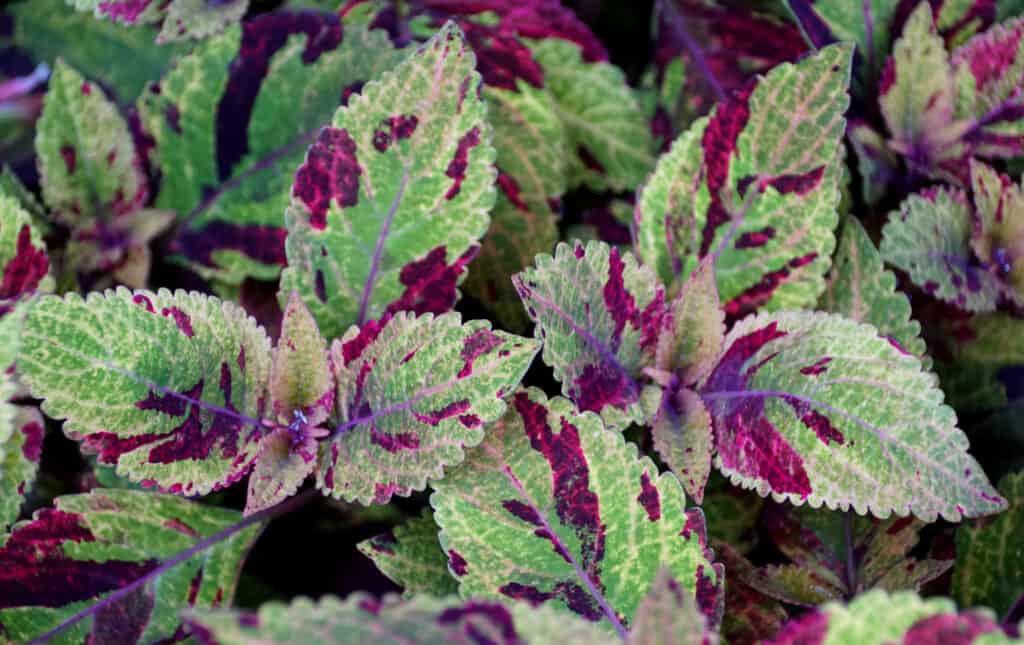
‘Mighty Mosaic’ coleus features intriguing patterns in shades of green, red and yellow.
©Khairil Azhar Junos/Shutterstock.com
Lime Delight
Height: 20 to 28 inches tall
Spread: 18 to 22 inches wide
Exposure: Full sun or filtered shade, depending on humidity
Description: ‘Lime Delight’ — not to be confused with ‘Limelight’ — is a vigorous, mound-growing cultivar with shiny, heart-shaped, light green to golden leaves. It can grow indoors or outdoors, and given its characteristic vibrant color, you can combine it with other darker varieties, such as ‘Palisandra.’

‘Lime Delight’ coleus is recognized by its shiny heart-shaped leaves.
©Nilkanth photography/Shutterstock.com
Premium Sun Crimson Gold
Height: 18 to 20 inches tall
Spread: 18 to 20 inches wide
Exposure: Partial shade or filtered sunlight
Description: This sturdy variety grows vertically, producing crimson-hearted foliage and golden edges, hence the name. The proportion and intensity of the colors will depend on how much sunlight it receives. This plant does not require much maintenance, but providing a moist, well-drained substrate will help.
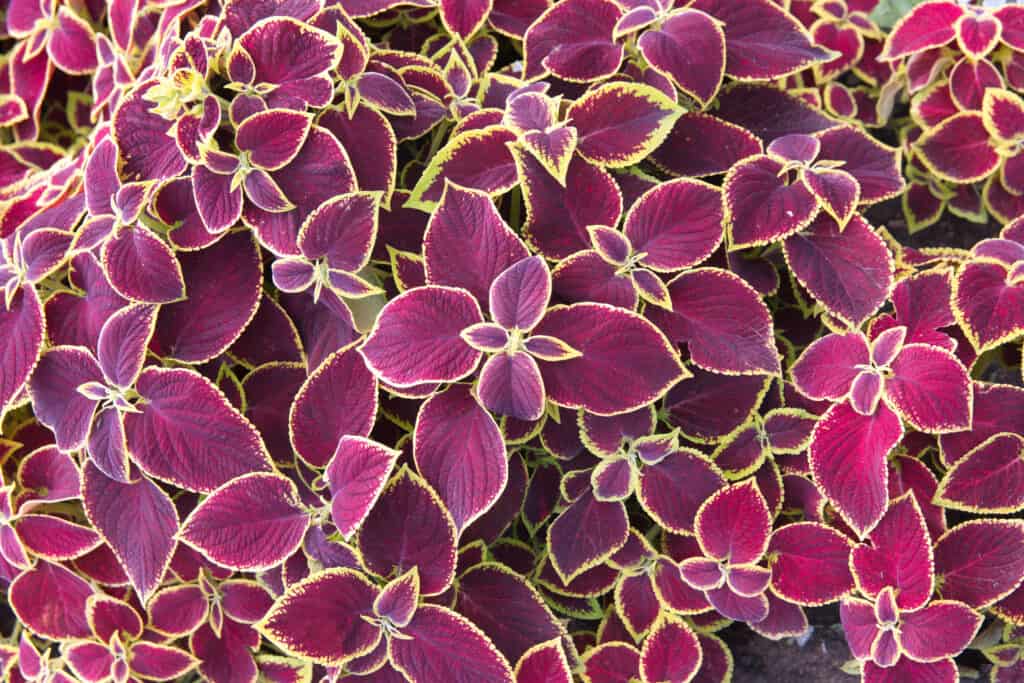
‘Premium Sun Crimson Gold’ coleus is a sturdy vertical-growing plant.
©aniana/Shutterstock.com
Kong Red
Height: 15 to 24 inches tall
Spread: 15 to 18 inches wide
Exposure: Partial sun or shade
Description: Undoubtedly a variety that will stand out in your garden or home, ‘Kong Red’ has elongated, deep red leaves with light green edges. It is a vibrant plant that grows vertically and does not require much effort to thrive.
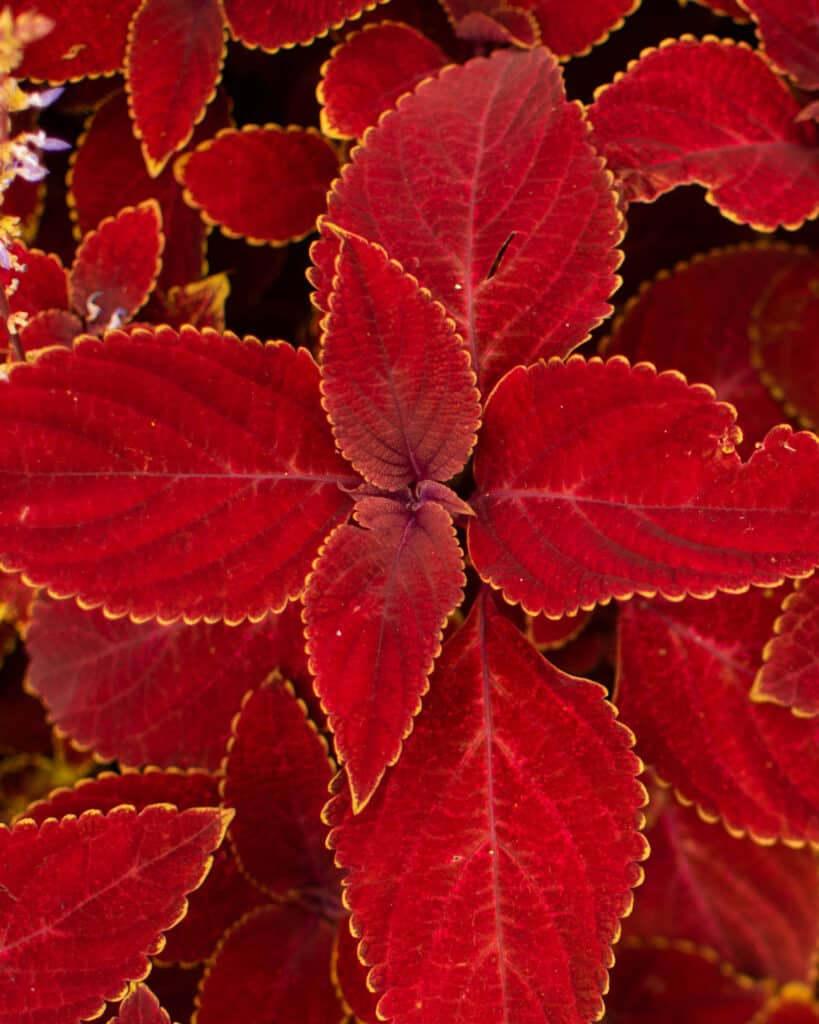
‘Kong Red’ coleus is striking in its crimson coloring and thin, yellow edges.
©Polapagi/Shutterstock.com
Superfine Rainbow Volcano
Height: 12 to 15 inches tall
Spread: 10 to 12 inches wide
Exposure: Partial sun or filtered shade
Description: The ‘Rainbow Volcano’ variety grows as a shrub with elongated leaves of a lively burgundy color and a super thin, very light green border. This cultivar can thrive in pots or the garden, and you can combine its intense color with greener varieties such as ‘Limelight.’

Whether potted or in the ground, ‘Superfine Rainbow Volcano’ coleus grows vertically and makes a stunning addition to any landscape design.
©Melissa Tate/Shutterstock.com
Superfine Rainbow Multicolor
Height: 12 to 14 inches tall
Spread: 10 to 12 inches wide
Exposure: Partial sun or shade
Description: This is the ideal cultivar if you are looking for a colorful variety that will revitalize your garden or home for an extended season. It grows quickly and efficiently, requires little maintenance, and its appearance is breathtaking. Its variegated leaves combine cream, magenta, burgundy, salmon, yellow, and green.
Premium Sun Dark Chocolate
Height: 24 to 30 inches tall
Spread: 18 to 24 inches wide
Exposure: Filtered shade to full sunlight
Description: This is another variety with large velvety heart-shaped leaves. Its deep chocolate color with crimson flashes depends on the sunlight it receives. It is a vigorous clumping plant, and its bold appearance can contrast with other more flowery or green plants.
Fairway Yellow
Height: 12 to 18 inches tall
Spread: 15 to 18 inches wide
Exposure: Full sun to full shade
Description: This bright yellowish-green variety grows mounded, making it optimal for planting in baskets and pots, alone or combined with other plants. This cultivar needs intense watering but survives by keeping its colorful touch for a long time.
Fairway Mosaic
Height: 8 to 10 inches tall
Spread: 8 to 10 inches wide
Exposure: Partial sun or shade
Description: This variety has striking foliage combining green or gold patterns with crimson or dark purple, making it a desirable cultivar for any home or garden. It prefers moist soil to thrive either in pots or in the ground.
Does Coleus Need Sun or Shade?
Coleus needs at least six hours of direct sunlight, with most cultivars thriving in morning sun and afternoon shade. Some varieties, such as ‘Premium Sun,’ tolerate direct sun in sufficiently humid environments.
Still, you should be looking for balanced sun exposure. If your plant receives direct sunlight without ambient humidity, its leaves will begin to scorch. Conversely, not receiving enough sunlight will cause etiolation, i.e., the stem will stretch in search of light, weakening. In addition, coleus needs sunlight to produce vibrant foliage and vivid colors.
Is Coleus Toxic for Pets?
Yes, coleus is a toxic plant for humans and animals, although not all species contain toxins.
Some varieties of coleus contain a compound called diterpene coleonol present in the oils and sap of the plant. Even so, this plant does not pose a significant danger to humans. Some people with sensitive skin may experience slight irritation, itching, or redness if they come in contact with the sap. Additionally, ingesting coleus may irritate the mouth and throat or cause gastrointestinal symptoms, although they do not pose a serious threat.
However, these toxins are dangerous to domestic animals, such as dogs, cats, or horses. Coleus poisoning can occur by ingesting the plant or absorbing its toxins through the skin, causing severe symptoms in these animals and even leading to death.
Some of the symptoms of coleus poisoning in pets are:
- Difficulty breathing
- Hypothermia
- Diarrhea
- Lethargy
- Vomiting
- Weakness
- Loss of appetite
- Tremors
How To Propagate Coleus Plants
Another advantage of beautifying your garden with coleus is that you can propagate these plants very easily, no matter what cultivar you choose. To successfully propagate coleus, you must do it in a suitable season, providing the plant with adequate humidity and temperature. Here are the easiest methods of propagating this plant.
From Cuttings
This is the propagation method par excellence, as it is almost foolproof, and you will have new plants very quickly. Ideally, you should do it in late fall or early spring, choosing the healthiest and best-formed stems. With a sharp, clean pruning shear, make precise cuts 4 to 6 inches long, just below the leaf node.
Remove the lower leaves, leaving only a few leaves at the top of the cutting. Leaves demand a lot of energy to photosynthesize, and your sprout needs that energy to grow roots. Optionally, you can dip the cuttings in rooting hormone, but you can skip this step, as this plant roots very quickly. You can then propagate them in water or soil.
Propagation in Water
You can place the cuttings in a glass of water or a vase, keeping the leaves from touching the water to reduce the chances of rotting. The water should always be clear, so we recommend changing it daily. In addition, the cuttings should receive indirect sunlight.
When using this method, you get to watch the roots grow at all times, so you can plant them when the cuttings have developed enough roots and grown new leaves.
Propagation in Soil
First, prepare a loose, well-drained substrate, making holes every 1 to 2 inches. Then, place the cuttings in these holes, covering them with the displaced soil, making sure that the leaves do not touch the soil. The soil must be damp but not wet, as your new plant needs hydration, which will help the roots to form.
Finally, cover the pot with plastic wrap so humidity doesn’t evaporate away, preventing the plastic from touching the leaves, and leave it in a place with indirect sunlight. You can remove the plastic after two or three weeks. You will know that your plant has rooted when new leaves grow.
Growing Coleus Seeds
Finally, another straightforward way to propagate coleus is by sowing its seeds, which you can easily get on the internet or in nurseries. The procedure is straightforward, but you’ll need to be patient, as it can take up to three weeks for the sprouts to appear. First, you must choose where to plant them — you can plant them in a large pot, leaving 1 to 2 inches between each seed. Also, use a loose substrate with good drainage to allow for growth, watering the seeds thoroughly. Ideally, your future plants should receive indirect sunlight.
Want to learn even more about this amazing plant? Check out our complete guide to coleus here.
Up Next:
- Coleus Plant Indoors: How to Successfully Grow Coleus in a Pot
- Is Coleus A Perennial Or Annual?
- Coleus Seeds: How to Start a Coleus
- Coleus Light Requirements: Do Coleus Prefer Sun or Shade?
The photo featured at the top of this post is © Astfreelancer/Shutterstock.com
Sources
- Gardening Know-How (1970) https://blog.gardeningknowhow.com/tbt/coleus-plant-history/
- Science Direct, Available here: https://www.sciencedirect.com/science/article/abs/pii/S098194280900148X
- Gardeners HQ, Available here: https://www.gardenershq.com/Coleus-painted-nettle.php
- Clemson, Available here: https://hgic.clemson.edu/factsheet/coleus/
- Sanbi, Available here: http://pza.sanbi.org/coleus-genus
- NCSU, Available here: https://plants.ces.ncsu.edu/plants/coleus-scutellarioides/
Thank you for reading! Have some feedback for us? Contact the AZ Animals editorial team.



